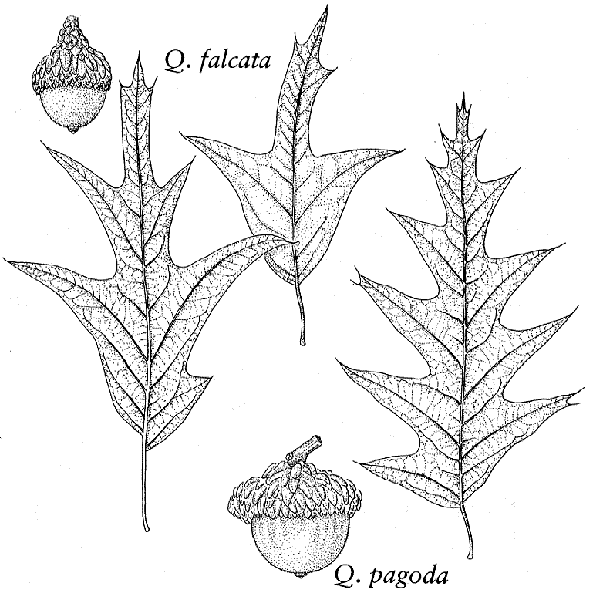| Quercus falcata | |
| Author | Michx. 1801 Hist. Chênes Amér. 28 |
| Synonyms | aurea Raf. 1838 cuneata Wangenh. 1787 digitata Sudw. 1892 discolor Spach, not Ait. elongata Muhl. 1801 hudsoniana Dippel 1891 rubra Sarg. not L. nec Duroi triloba Michx 1803 |
| Local names | Spanish
red oak; swamp red oak; southern red oak ; |
| Range | SE USA; to 750 m; introduced in Europe en 1763; |
| Growth habit | 20-30
m; trunk short, crown rounded; |
| Leaves | 8-30 x 5-15 cm; 3 to 7 lobes elongated, sickle-shaped, with deep sinuses; thick; base rounded; lustrous dark green above, with rusty hairs beneath; petiole yellowish, often pubescent, 2-5 cm; autumn leaves have not the red color of other species of "red oaks". |
| Flowers | |
| Fruits | acorn
1-2 cm, singly or paired; globose; apex often striate; cup shallow, scaly,
broad, enclosing 1/3 of nut; maturing in 2 years; first acorns when the
tree is 25 year old; |
|
Bark, twigs and |
bark
dark grey, deeply furrowed into thick plates; inner bark is light yellow,
as in Q.velutina; twigs angled, with rusty hairs; bud light brown,
silky near apex, 4-8 mm long; |
| Hardiness zone, habitat | hardy; prefers acidic, dry soils, even poor or clayey; |
| Miscellaneous | --
A. Camus : n° 419; -- Sub-genus Quercus, section Lobatae, sub-section Phellos; -- "Spanish", because present on the territory of the first Spanish colonies; -- Numerous hybrids, among them : Q.x caesariensis with Q.ilicifolia, Q.x beaumontiana with Q.laurifolia ; |
| Subspecies and varieties |
---
var. pagodifolia Elliott = Q.pagoda
Rafinesque (see this name); |
| Pictures |
|







